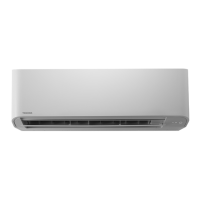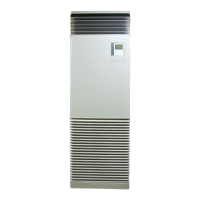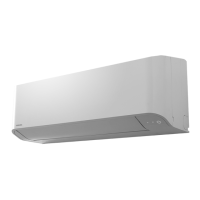
Do you have a question about the Toshiba RAV-HM1101KRTP-E and is the answer not in the manual?
| Brand | Toshiba |
|---|---|
| Model | RAV-HM1101KRTP-E |
| Category | Air Conditioner |
| Language | English |
Details on the components of the indoor air conditioning unit.
Explains the buttons and display of the wireless remote controller.
Step-by-step guide to set the clock on the remote controller.
Instructions for operating the air conditioner in cooling, heating, or fan-only modes.
Guide for using the dry mode for dehumidification.
How to use the auto-changeover function for different conditions.
Setting and cancelling timer functions for operation.
Illustrates how multiple indoor units can be controlled as a group.
Procedure to enable automatic restart after power interruption.
Procedure to disable the auto restart function.
How the unit automatically selects modes based on room temperature.
Explanation of the high-power mode for rapid cooling or heating.
Details on the sleep mode for comfortable temperature adjustment.
Information about the low-noise operation mode.
How the dry mode functions for dehumidification.
Tips for efficient energy usage and comfortable room conditions.
How to operate the unit temporarily without the remote controller.
Instructions for cleaning the main components of the air conditioner.
Steps to prepare the unit for long-term storage.
Guide on how to clean the air filters for optimal performance.
Instructions for cleaning the air inlet grille.
Procedures for storing the unit when unused for an extended period.
Preparations needed before the start of the cooling season.
Recommendations for regular checks and professional maintenance.
Describes symbols used for carton marking.
Highlights additional safety warnings for handling.
Points to check before requesting professional servicing for common issues.
Pre-operation checks to ensure safe and proper functioning.
Explanation of the delay timer for compressor protection.
How the unit behaves during and after a power outage.
Details on the automatic defrosting process for heating.
Information on how the unit provides heat and its limitations.
How the unit's safety mechanisms operate and indicate faults.
Advice on managing power supply during the operating season.
Precautions for outdoor unit protection in snowy or freezing conditions.
Guidelines on unsuitable locations for installing the air conditioner.
Considerations for minimizing noise and vibration during installation.
Details about the manufacturing company.
Information about the Technical Construction File holder.












